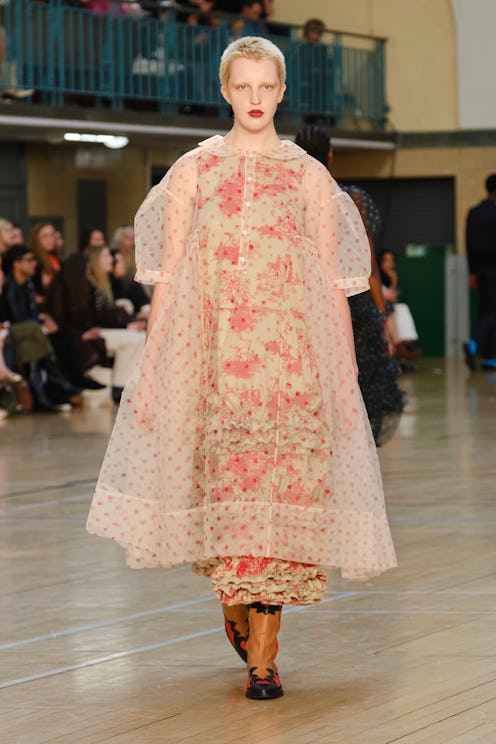(Fashion Week)
Molly Goddard's Spring 2023 Show Offered A New Way To Wear Cowboy Boots
Just add a ballgown.

No one does party dressing like Molly Goddard. Since the launch of her eponymous label in 2014, the London-based designer has moved to the beat of her own fanciful drum, delivering candy-colored tiered confections season after season. But while Goddard’s Spring/Summer 2023 collection, which debuted this Saturday, was certainly full of her signature fairy-like frocks, the designer also worked in her own spin on some of 2022’s biggest style trends... including cowboy boots.
Yes, amidst some more typical spring attributes — soft florals, cloudy polka-dot prints, lightweight shift dresses, and candy-colored suiting — unexpected pairings by way of the aforementioned (and very American) western boots and juxtaposed layering offered some interest and dimension to traditional warm-weather looks.
“I was thinking about red carpets pre-internet,” says Goddard in the official show notes. “These are images I love and often go to for inspiration, dressing felt more for the party and for yourself. Much more casual, laid back. No step and repeat and no posing. People looked like they were out to have fun.”
Part of said fun included creating interest and dimension with strategic layering. Indeed, Goddard doubled down on a combination that’s been creeping into the fashion sphere over the past year: dresses over pants. While past runways have shown the trend styled with slinky slip dresses thrown atop slouchy denim, the English designer’s approach read more British garden party than Y2K house rager. Off-the-shoulder, bubble-hemmed mini dresses (a breakout trend of the Spring/Summer 2023 runways) were layered over cropped slacks featuring fun pastoral prints of bunnies, mice, and foliage. Grounding the otherwise precious look was, that’s right, color-blocked cowboy boots.
Goddard pointed to legendary English-American designer Charles James as another specific source of inspiration for her most recent work. The late artist is considered one of the most influential fashion designers of the 20th century, known for his structured ball gowns and evening wear. “He strove for perfection which isn’t something I’m interested in but more the exploration of creating shapes on the body, changing proportions of the body — that element inspired this season, pushing fabrics to their extremes, utilizing the qualities of each fabric and letting it do the work,” explains Goddard in the show notes. “There is juxtaposition in the fabric choices, intricately cut evening dresses in cotton, ball-gowns in jersey.”
Juxtaposition surely was a resounding theme, as the designer mixed-and-matched a multitude of opposing silhouettes: floaty, sheer dressing gowns over structured midi-dresses, ruffled peplum minis that hovered above tiered, ankle-length midi skirts, ruffled accents on streamlined suit jackets, and fitted neon collared cardigans paired with voluminous tiered gowns.
The contrast continued with color as all manner of neons and spring-forward shades were paired in combos that blatantly eschewed anything you learned about the color wheel — think lime green and lilac, red and teal, tangerine and fuchsia.
Even the formatting of the show and its bare-bones athletic venue, the Seymour Leisure Centre, felt like a stark contrast to the collection’s precious vibe. Instead of the single-line procession, models haphazardly walked the perimeter of the basketball court, an intentional move on Goddard’s part. “I wanted the staging of the show to feel like a break from relentless scrolling, the experience of watching in person is different to seeing it online — slower, messier, more spacious,” she explains in the show notes.
Ahead, a visual breakdown of the whimsical show in all its maximalist glory.
This article was originally published on